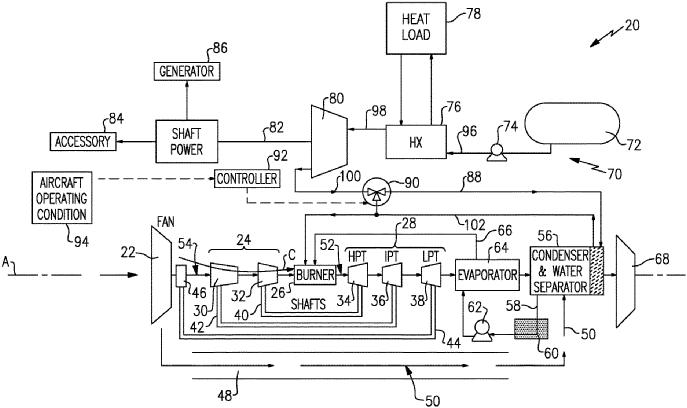Raytheon Technologies Corporation has recently filed a patent for a novel hydrogen-based propulsion system designed for aircraft.
This patent, submitted on August 1, 2024, is poised to make waves in the aerospace industry. The system comprises a core engine incorporating a compressor, combustor, and turbine, as well as an advanced fuel and heat exchange mechanism.
Unique Features and Improvements
This hydrogen propulsion system stands out due to several unique features that enhance its efficiency and performance compared to existing technologies. One of the critical innovations is the integration of a turboexpander and dual heat exchangers, which together optimize the thermal management of the propulsion system. The first heat exchanger extracts the initial heat load from the cooling flow, while the turboexpander subsequently uses this heated flow to generate shaft power before cooling it further. The second heat exchanger then manages the remaining thermal load, ensuring a stable and efficient temperature profile throughout the system.
Potential Applications
This patented technology has wide-reaching applications within the aerospace domain. Primarily, it is intended for use in commercial and military aircraft, potentially revolutionizing the way these vehicles operate by offering a cleaner and more efficient fuel alternative to traditional hydrocarbons. Beyond aviation, similar hydrogen-based propulsion systems could be adapted for use in spacecraft, unmanned aerial vehicles (UAVs), and even marine vessels.
The introduction of this hydrogen propulsion system could significantly impact the aerospace market. As the industry faces increasing pressure to reduce carbon emissions, hydrogen fuel presents a promising solution due to its clean-burning properties. Raytheon’s innovation could thus pave the way for more sustainable aviation technologies, leading to potentially lower operating costs and reduced environmental impact.
In comparison to existing solutions, Raytheon’s hydrogen propulsion system offers several advantages. Traditional jet engines rely heavily on fossil fuels, which are both finite and carbon-intensive. Hydrogen, by contrast, is abundant and produces water as its primary combustion byproduct. While competitors such as General Electric and Rolls-Royce have also been exploring hydrogen propulsion technologies, Raytheon’s integration of a turboexpander and dual heat exchangers might give it an edge in terms of thermal efficiency and overall system performance.
Technical Specifications and Processes
– Core Engine: Incorporates a compressor section for air compression, a combustor section for mixing and igniting fuel, and a turbine section for expanding exhaust gas.
– Fuel System: Supplies the hydrogen fuel to the combustor through a designated flow path.
– Heat Exchangers: A dual heat exchange process to manage heat loads efficiently.
– Turboexpander: Utilizes heated cooling flow to generate mechanical shaft power, enhancing overall system efficiency.
– Cooling Flow Management: Post-turboexpander cooling flow is further thermally adjusted via the second heat exchanger before returning to the combustor section.





